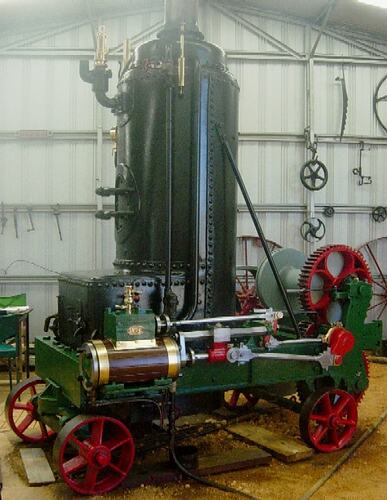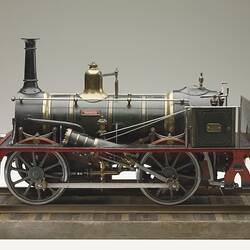Summary
Portable self-contained horizontal single-cylinder 6-inch (152 mm) bore x 12-inch (305 mm) stroke, double-drum, portable steam winch known colloquially as a "donkey engine" or "pier donkey engine". The winch is believed to be the last surviving example of over twenty similar machines that operated on the Melbourne waterfront loading and unloading cargo, between the 1850s and the 1920s. The engine incorporates several American style design features typical of the 1850s and is believed to have either been built in America or in Victoria as a copy of an imported American design. The winch was restored to working order by Brian Redfearn between 1982 and 1988, being fitted with a welded water-tube type boiler with independent pressure vessel inside the old boiler shell, allowing it to be operated under steam.
The winch was found by the restorer lying derelict and overgrown with blackberries in a farm paddock off Stumpy Gully Road on the Mornington Peninsula in 1980. It was last used to provide power for cutting firewood during the 1930s depression, before being abandoned when the boiler tubes collapsed. Victorian boiler inspection records (file B.I.A. 7730) reveal that after lying unused for some years in the yard of the machinery and timber merchant H. Carpenter in City Road, South Melbourne, the winch had been sold in 1930 to Thomas Grey's Granite Quarries at Dandenong. A subsequent note, dated 23-8-1932, indicated that the sale fell through and the winch had not left Carpenter's yard, because Thomas Grey could not raise enough money for the deposit. Prior to 1930 the winch had been working under the Melbourne Harbour Trust and was fitted with a new mild-steel boiler by ship repair & engineering firm D. & R. Buchanan, of South Melbourne, in about 1890, replacing the original wrought-iron boiler which was of a similar external design. The Museum holds a number of artefacts from the Buchanan & Brock workshop, including a set of plate bending rolls (ST 43438), which quite likely were used in the manufacture of this actual boiler.
Early photographs indicate that steam donkey engines of almost identical design to this engine were in use on the privately-owned pier of the Melbourne & Hobsons Bay Railway Company at Sandridge (later Port Melbourne) by 1860. By the 1880s, similar donkey engines can also been seen in photos & etchings of the Government-owned railway piers at Williamstown and on the Yarra wharves. As steam ships were introduced they had their own steam supply and deck mounted steam winches onboard, which reduced the need for pier engines and their use appears to have gradually declined. They are no longer apparent in photos of the Port Melbourne and Williamstown piers taken around 1900, but can still be seen in photos of the South Yarra Wharves, which continued to be used by the last of the sailing ships engaged in the timber trade until the 1920s.
The first company to introduce steam winches of this type to the Port of Melbourne, was G.W. Robbins & Co, founded by George Washington Robbins, who was born in Portsea, England and emigrated to Victoria in 1853. By 1855, G.W. Robbins was residing in Stoke Street, Port Melbourne, close to the Hobsons Bay Railway Pier and from 1858 to 1872 "G.W. Robbins & Co., stevedores" are listed in the Sands and McDougall Directories as a business operating from 17 Stoke Street, Sandridge (now known as Port Melbourne). G.W. Robbins' brother Frank Robhins, was also involved in the business and had spent some years in America working as a stevedore during the early 1850s before emigrating to Victoria. In later years the firm changed its name to Frank Robbins & Sons.
On an early business card, G.W. Robbins describes himself as "The Pioneer Stevedore of Victoria" and a photograph shows him standing beside a winch virtually identical in appearance to the machine now owned by the Museum. Robbins' business card states that "the first ship discharged by steam was the ship Queen of the East". Searches of early Port of Melbourne shipping records reveal that a Liverpool clipper ship named the "Queen of the East" made two visits to Melbourne in 1854 and 1855 carrying immigrants and general cargo.
Physical Description
Features a wood and brass lagged double-acting steam cylinder with overhead steam chest and D-slide valve, diamond-section single-bar crosshead guide, driving two horizontally-mounted spur-gear driven contra-rotating winch drums (on second-motion & third-motion). Each winch drum has an independent hand-lever operated dog-clutch and originally had foot-pedal operated band brakes. Boiler consists of an L-shaped vertical tubular boiler, similar to a common locomotive style boiler stood on end, with a rectangular horizontal firebox and vertical barrel which originally contained a bank of multiple fire-tubes feeding the exhaust into a central uptake chimney. The boiler has a rivetted mild-steel shell and was rated at 60 psi (413 kPa) working pressure. The engine, winch mechanism and boiler are mounted on a cast-iron frame with four cast-iron wheels. A long-stroke feed-water pump is mounted on the opposite side of the firebox to the steam cylinder. During restoration the tube-plates and fire-tubes were removed from the inside of the boiler barrel and replaced with self-contained water-tube steam generator comprising a welded dome-ended cylindrical pressure vessel with U-shaped water-tubes in a spiral configuration.
Significance
This early steam-powered winding engine is a unique survivor from Melbourne's gold-rush era of the 1850s, with a direct connection to one of the most colourful characters of the city's early waterfront and to the introduction of steam-powered cargo handling in the Port of Melbourne. It is believed to have been built in America around 1853-1860, and is the only known surviving example from dozens of similar 'donkey engines' which once lined Melbourne's piers and wharves from the mid 1850s to the early 1900s. The engines were used to assist in the loading and unloading of import and export cargoes from sailing ships. The object is also of additional significance as one of the oldest surviving steam engines used in Victoria and it the oldest surviving Victorian steam artefact that demonstrates a clear American design influence, as opposed to the far more usual British influence on early Australian steam technology.
More Information
-
Collecting Areas
-
Acquisition Information
Purchase
-
Acknowledgement
Purchased with the assistance of the Australian Government through the National Cultural Heritage Account.
-
Past Owner (Probable)
G.W. Robbins & Co, Sandridge (Port Melbourne), Greater Melbourne, Victoria, Australia, circa 1860-1872
-
Manufacturer of Component
D.& R. Buchanan, South Melbourne, Greater Melbourne, Victoria, Australia, circa 1890
D.& R. Buchanan made a replacement boiler for the winch in about 1890. -
Past Owner or User
Melbourne Harbour Trust (MHT), South Wharf, South Melbourne, Greater Melbourne, Victoria, Australia, circa 1920s
-
User (Probable)
Melbourne & Hobson's Bay United Railway Co., Sandridge (Port Melbourne), Greater Melbourne, Victoria, Australia, circa 1860-1878
-
Inscriptions
Fitted with an oval brass plate with a cast number "13" fixed to the steam chest.
-
Classification
-
Category
-
Discipline
-
Type of item
-
Overall Dimensions
2580 mm (Length), 1610 mm (Width), 2580 mm (Height), 3320 kg (Weight)
Note: Overall height includings chimney of approx 0.5 m which can be unbolted for transport.
-
References
[Other] Barnard, Jill. 2008. Jetties and Piers - A background history of maritime infrastructure in Victoria.
-
Keywords
Cargo Handling Equipment, Hobsons Bay Railway Pier, Port of Melbourne, Sailing Vessels, Steam Engines, Steam Power, Steam Winches



